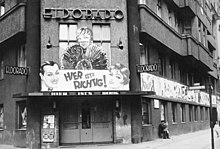Gay bar
With the advent of the Internet and an increasing acceptance of LGBTQ+ people across the Western world, the relevance of gay bars in the LGBTQ+ community has somewhat diminished.Reports from as early as the 17th century record the existence of bars and clubs that catered to, or at least tolerated, openly gay clientele in several major European cities.[10] Paris retained the LGBTQ+ capital image after the end of World War II, but the center of the meeting place shifted to Saint-Germain-des-Prés.[11] Chez Moune, opened in 1936, and New Moon were 20th-century lesbian cabarets located in Place Pigalle, which converted to mixed music clubs in the 21st century.Especially in the Schöneberg district around Nollendorfplatz there were many cafes, bars and clubs, which also attracted gay people who had to flee their own country in fear of prosecution, like for example Christopher Isherwood.Since the 1960s, the Rosa Viertel (pink quarter) developed in the Glockenbachviertel and around Gärtnerplatz, which in the 1980s made Munich "one of the four gayest metropolises in the world" along with San Francisco, New York City and Amsterdam.Regulars in many of these bars and nightclubs include, for example, Freddie Mercury, Rainer Werner Fassbinder, Walter Sedlmayr (who met his later murderer in the Pimpernel), Inge Meysel and Hildegard Knef.[20] Because of a raid on a Mexico City drag ball in 1901, when 41 men were arrested, the number 41 has come to symbolize male homosexuality in Mexican popular culture, figuring frequently in jokes and in casual teasing.Relative freedom from official harassment continued until 1959 when Mayor Ernesto Uruchurtu closed every gay bar following a grisly triple-murder.[23] Today, Mexico City is home to numerous gay bars, many of them located in the Zona Rosa, particularly on Amberes street, while a broad and varied gay nightlife also flourishes in Guadalajara, Acapulco, in Cancun attracting global tourists, Puerto Vallarta which attracts many Americans and Canadians, and Tijuana with its cross-border crowd.After World War II, the Amsterdam city government acted rather pragmatic and tolerated the existence of gay bars.In 2013, Moscow's largest gay bar, Central Station, had its walls sprayed with gunfire, had harmful gas released into a crowd of 500 patrons, and had its ceiling nearly brought down by a gang who wanted to crush the people inside.[31] The history of gay and lesbian bars in South Africa reflects the racial divisions that began in the Apartheid era and continue, to some extent, in the 21st century.[32] The first white gay bar opened in the Carlton Hotel in downtown Johannesburg in the late 1940s, catering exclusively to men of wealth.In 1968, when the government threatened to pass repressive anti-gay legislation, queer culture went even further underground, which meant clubs and bars were often the only places to meet.[34] In the 1980s, police raids on white gay clubs lessened as the apartheid government forces found itself dealing with more and more resistance from the black population.In the black townships, some of the shebeens, unlicensed bars established in people's homes and garages, catered to LGBTQ clients.But in recent years, more clubs have located in the Sinchon area, indicating that "safe spaces" for Korean LGBTQ+ people have extended beyond the foreign zones, which were traditionally more tolerant.[44] The first gay bar in Britain in the modern sense was The Cave of the Golden Calf, established as a night club in London.After homosexuality was partially decriminalized in the UK in 1967, gay bar culture became more visible and gradually Soho became the centre of the London LGBTQ+ community, which was "firmly established" by the early 1990s.In alphabetical order: Gay bars have been heavily impacted by the epidemiology of HIV/AIDS with both potential risk and crucial community support and education.Specifically, the research indicated that individuals who frequented gay bars were more likely to engage in insertive unprotected anal intercourse, including with partners whose HIV status differed from their own.[68] June Thomas explained the decline by noting that there is less need for gay-specific venues like bars because gay people are less likely to encounter discrimination or be made unwelcome in wider society.[69] Entrepreneur magazine in 2007 included them on a list of ten types of business that would be extinct by 2017 along with record stores, used bookstores and newspapers.[71][72][73][74][75] But despite the decline, gay bars still exist in relatively strong numbers and thrive in most major cities where male homosexuality is not heavily condemned.Some of the longest established gay bars are unofficial hosts of elaborate local 'Royal Court' drag pageants and drag-related social groups.In some establishments, people who are perceived to be of the "wrong" sex (for example, a man attempting to enter a women's club) may be unwelcome or even barred from entry.











Gay Bar (song)Comptons of SohoLondonLondon Pridedrinking establishmentlesbianbisexualtransgenderLGBTQ+same-sexgender-variantlesbian barLGBTQ+ communitygay nightnightclubTammelaTampereFinlandVere StreetVere Street Coteriesodomygay marriagesReverend John ChurchCannesLGBT history in ChinaBeijingQiao QiaoLGBT rights in DenmarkCopenhagenLatin QuarterJean MaraisThierry Le LuronColucheLGBT culture in ParisMontmartrePigalleAmsterdamBerlinWorld War IISaint-Germain-des-PrésChez MouneNew MoonPlace PigalleLe MaraisLGBT culture in BerlinFirst homosexual movementSchönebergNollendorfplatzChristopher IsherwoodMotzstraßetransvestiteWest BerlinMunichGolden TwentiesMüllerstraßetravestyFreddie MercuryLiving on My Ownleather menRainer Werner FassbinderWalter SedlmayrInge MeyselHildegard KnefLGBT in TokyoShinjuku Ni-chōmeLGBT history in MexicoMexico CityMexican popular cultureinternational depression of the 1930sgay bathhousesSecond World Warharassmentdance clubsbribesGuadalajaraAcapulcoVeracruzZona RosaCancunPuerto VallartaTijuanaLGBT history in the NetherlandsCafé 't MandjeBet van Beerengay villagesZeedijkWarmoesstraatleather sceneThe Queen's HeadLGBT culture in RussiahomophobiaLGBT history in SingaporeKenneth WilliamsSingaporeLGBT rights in South AfricaApartheidJohannesburgCape ColouredAfrikaansStonewallshebeensSowetoLGBT History in South KoreaItaewonSinchonLGBT history in SpainGeneral Francisco FrancoTorremolinosBarcelonaLGBT history in TaiwanLGBT culture in Londonmolly housesThe Cave of the Golden Calfnight clubRegent StreetFrida Strindberg née Uhlavant-gardeOld Compton StreetStanley Street QuarterMerchant CityCanal StreetBirmingham Gay VillageProhibitionAtlantic HouseProvincetown, MassachusettsTennessee Williams
